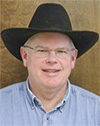Performance of stockers and growers is very closely related with feed intake and feed quality. This is just as true with grazing livestock as it is in a feedlot setting. Pasture and grazing management are vitally important to feed intake and forage quality.
The general rule for grazing animals is that intake is 75 percent forage availability and 25 percent forage quality.
According to grazing expert Jim Gerrish, “Voluntary forage intake of livestock is determined by the amount of time that animals spend grazing, their biting rate and bite size.” As managers, we have little to no control over grazing time and biting rate. We do, however, have control over bite size.
Cattle that have access to pastures with sufficient standing forage are better able to wrap their tongues around it and consume more forage during the time spent grazing. Feed intake is maximized when standing forage is 6 to 15 inches in height.
What to leave, what to take
Oftentimes, we focus on when a pasture is ready to graze. Is there sufficient growth or forage available for the animals to remain for the required number of days? While this is an important consideration, it is even more important to look at the remaining forage where the cattle are currently grazing.
Just how much is left (residual) has a dramatic impact on intake. Gerrish states that 82 percent of the variation in animal intake is explained by post-grazing residual.
A frequently repeated phrase at the University of Idaho Extension’s Lost Rivers Grazing Academy is “What you leave behind is more important than what you take,” again emphasizing the importance of post-grazing residual.
Some managers may think that cattle will graze continually until they are full. While they may graze longer if they are not able to fill up, cattle still require time for rumination and rest. The maximum average amount of time cattle usually graze in a day is approximately 10 hours, although lactating animals may graze up to 12 hours per day.
If forage is short and bite size is small, they will not physically consume a sufficient quantity of forage for maximum production, even if the forage is high-quality. This could easily mean the difference between 1 pound or less average daily gain and 3 pounds or more average daily gain.
Maximizing intake is vital to maximizing animal performance.
One of the most important grazing principles for maximizing intake is that of using the shortest grazing period possible. This simply means that cattle should have access to a specific paddock or pasture for a short period of time. As animals graze, forage is trampled or fouled with manure and urine.
In addition to this, cattle are selective grazers and will consume the best forage available first. The longer the time they are in a specific pasture, the lower the quality of available feed will be. This will also negatively affect intake and, consequently, animal performance.
The amount of post-grazing residual will also affect forage recovery rate. Forages rely on photosynthesis to grow. The process of photosynthesis takes place in the chloroplasts in the plant. Chloroplasts are found mainly in the leaves of the plant.
Plants that are left with more leaf area have greater ability to photosynthesize than plants with little or no leaf area. Thus, forage plants left with more post-grazing residual will grow and recover more quickly and be ready to regraze much sooner than pastures grazed short.
Additional recovery benefits
Besides quicker recovery, there are additional benefits for leaving taller residuals. Well-managed pastures with moderate levels of forage utilization followed by adequate rest and recovery develop deep and healthy root systems. This helps plants to be more drought-resistant, as these plants will have access to moisture from deeper in the soil profile.
The additional root mass will aid the plant in acquiring available nutrients from the soil.
Additionally, the increased biomass aboveground coupled with the increased root mass underground will improve water infiltration into the soil. This means that more of the moisture that falls, whether from natural precipitation or irrigation, will remain in place rather than runoff.
Research conducted in 1937 by the University of Nebraska and the USDA Soil Conservation Service demonstrated that pasture with 10 percent slope and 95 percent ground cover retained 90 percent of the precipitation with no soil loss during a simulated major storm event (3 inches of water in 90 minutes).
That same pasture/soil with 75 percent ground cover retained only about 45 percent of the precipitation and lost 0.5 ton per acre of soil. That same pasture/soil with 50 percent ground cover retained only 25 percent of the precipitation and lost over 4 tons of soil per acre.
There are many benefits to managing for taller residuals in pastures. To reap these benefits, grazing managers must overcome the “fear” of wasting grass. Both animal performance and pasture productivity can be enhanced by leaving behind more than what we take. ![]()
If you would like to learn more about managing pastures, join us for the 2017 Lost Rivers Grazing Academy. For information on the academy, go to Owyhee County Eextension Office and follow the link.

-
Scott Jensen
- University of Idaho
- Owyhee County Extension Educator – Livestock and Range
- Email Scott Jensen








